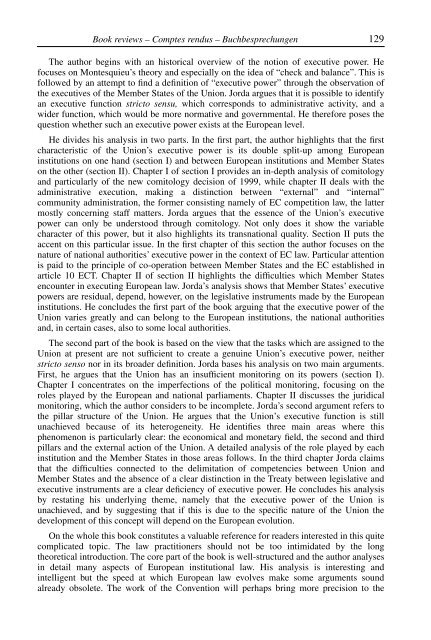journal of european integration history revue d'histoire de l ...
journal of european integration history revue d'histoire de l ...
journal of european integration history revue d'histoire de l ...
You also want an ePaper? Increase the reach of your titles
YUMPU automatically turns print PDFs into web optimized ePapers that Google loves.
Book reviews – Comptes rendus – Buchbesprechungen 129<br />
The author begins with an historical overview <strong>of</strong> the notion <strong>of</strong> executive power. He<br />
focuses on Montesquieu’s theory and especially on the i<strong>de</strong>a <strong>of</strong> “check and balance”. This is<br />
followed by an attempt to find a <strong>de</strong>finition <strong>of</strong> “executive power” through the observation <strong>of</strong><br />
the executives <strong>of</strong> the Member States <strong>of</strong> the Union. Jorda argues that it is possible to i<strong>de</strong>ntify<br />
an executive function stricto sensu, which corresponds to administrative activity, and a<br />
wi<strong>de</strong>r function, which would be more normative and governmental. He therefore poses the<br />
question whether such an executive power exists at the European level.<br />
He divi<strong>de</strong>s his analysis in two parts. In the first part, the author highlights that the first<br />
characteristic <strong>of</strong> the Union’s executive power is its double split-up among European<br />
institutions on one hand (section I) and between European institutions and Member States<br />
on the other (section II). Chapter I <strong>of</strong> section I provi<strong>de</strong>s an in-<strong>de</strong>pth analysis <strong>of</strong> comitology<br />
and particularly <strong>of</strong> the new comitology <strong>de</strong>cision <strong>of</strong> 1999, while chapter II <strong>de</strong>als with the<br />
administrative execution, making a distinction between “external” and “internal”<br />
community administration, the former consisting namely <strong>of</strong> EC competition law, the latter<br />
mostly concerning staff matters. Jorda argues that the essence <strong>of</strong> the Union’s executive<br />
power can only be un<strong>de</strong>rstood through comitology. Not only does it show the variable<br />
character <strong>of</strong> this power, but it also highlights its transnational quality. Section II puts the<br />
accent on this particular issue. In the first chapter <strong>of</strong> this section the author focuses on the<br />
nature <strong>of</strong> national authorities’ executive power in the context <strong>of</strong> EC law. Particular attention<br />
is paid to the principle <strong>of</strong> co-operation between Member States and the EC established in<br />
article 10 ECT. Chapter II <strong>of</strong> section II highlights the difficulties which Member States<br />
encounter in executing European law. Jorda’s analysis shows that Member States’ executive<br />
powers are residual, <strong>de</strong>pend, however, on the legislative instruments ma<strong>de</strong> by the European<br />
institutions. He conclu<strong>de</strong>s the first part <strong>of</strong> the book arguing that the executive power <strong>of</strong> the<br />
Union varies greatly and can belong to the European institutions, the national authorities<br />
and, in certain cases, also to some local authorities.<br />
The second part <strong>of</strong> the book is based on the view that the tasks which are assigned to the<br />
Union at present are not sufficient to create a genuine Union’s executive power, neither<br />
stricto senso nor in its broa<strong>de</strong>r <strong>de</strong>finition. Jorda bases his analysis on two main arguments.<br />
First, he argues that the Union has an insufficient monitoring on its powers (section I).<br />
Chapter I concentrates on the imperfections <strong>of</strong> the political monitoring, focusing on the<br />
roles played by the European and national parliaments. Chapter II discusses the juridical<br />
monitoring, which the author consi<strong>de</strong>rs to be incomplete. Jorda’s second argument refers to<br />
the pillar structure <strong>of</strong> the Union. He argues that the Union’s executive function is still<br />
unachieved because <strong>of</strong> its heterogeneity. He i<strong>de</strong>ntifies three main areas where this<br />
phenomenon is particularly clear: the economical and monetary field, the second and third<br />
pillars and the external action <strong>of</strong> the Union. A <strong>de</strong>tailed analysis <strong>of</strong> the role played by each<br />
institution and the Member States in those areas follows. In the third chapter Jorda claims<br />
that the difficulties connected to the <strong>de</strong>limitation <strong>of</strong> competencies between Union and<br />
Member States and the absence <strong>of</strong> a clear distinction in the Treaty between legislative and<br />
executive instruments are a clear <strong>de</strong>ficiency <strong>of</strong> executive power. He conclu<strong>de</strong>s his analysis<br />
by restating his un<strong>de</strong>rlying theme, namely that the executive power <strong>of</strong> the Union is<br />
unachieved, and by suggesting that if this is due to the specific nature <strong>of</strong> the Union the<br />
<strong>de</strong>velopment <strong>of</strong> this concept will <strong>de</strong>pend on the European evolution.<br />
On the whole this book constitutes a valuable reference for rea<strong>de</strong>rs interested in this quite<br />
complicated topic. The law practitioners should not be too intimidated by the long<br />
theoretical introduction. The core part <strong>of</strong> the book is well-structured and the author analyses<br />
in <strong>de</strong>tail many aspects <strong>of</strong> European institutional law. His analysis is interesting and<br />
intelligent but the speed at which European law evolves make some arguments sound<br />
already obsolete. The work <strong>of</strong> the Convention will perhaps bring more precision to the

















